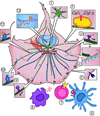Interphase microtubules: chief casualties in the war on cancer?
- PMID: 24201225
- PMCID: PMC4009386
- DOI: 10.1016/j.drudis.2013.10.022
Interphase microtubules: chief casualties in the war on cancer?
Abstract
Microtubule-targeting agents (MTAs) profoundly affect interphase cells, such as by disrupting axonal transport, transcription, translation, mitochondrial permeability, immune cell function, directional migration and centrosome clustering. This finding is antithetical to the conventionally held notion that MTAs act on mitosis to trigger arrest-mediated apoptotic cell death. Furthermore, the paucity of mitotic cells in patient tumors and lack of correlation of MTA efficacy with tumor proliferation rate provide strong impetus to re-examine the mechanistic basis of action of MTAs, with an eye toward interphase activities. Whereas targeted antimitotics have unequivocally failed their promise across clinical studies, MTAs constitute a mainstay of chemotherapy. This paradox necessitates the conclusion that MTAs exert mitosis-independent effects, spurring a dramatic paradigm shift in our understanding of the mode of action of MTAs.
Copyright © 2013 Elsevier Ltd. All rights reserved.
Figures


Similar articles
-
Mitosis is not a key target of microtubule agents in patient tumors.Nat Rev Clin Oncol. 2011 Feb 1;8(4):244-50. doi: 10.1038/nrclinonc.2010.228. Nat Rev Clin Oncol. 2011. PMID: 21283127 Review.
-
A new perspective on old drugs: non-mitotic actions of tubulin-binding drugs play a major role in cancer treatment.Pharmazie. 2013 Jul;68(7):478-83. Pharmazie. 2013. PMID: 23923626 Review.
-
The microtubule targeting agent ST-401 triggers cell death in interphase and prevents the formation of polyploid giant cancer cells.J Transl Med. 2024 May 10;22(1):441. doi: 10.1186/s12967-024-05234-3. J Transl Med. 2024. PMID: 38730481 Free PMC article.
-
Microtubule-targeting agents and their impact on cancer treatment.Eur J Cell Biol. 2020 May;99(4):151075. doi: 10.1016/j.ejcb.2020.151075. Epub 2020 May 1. Eur J Cell Biol. 2020. PMID: 32414588 Review.
-
Microtubule-targeting agents are clinically successful due to both mitotic and interphase impairment of microtubule function.Bioorg Med Chem. 2014 Sep 15;22(18):5050-9. doi: 10.1016/j.bmc.2014.02.035. Epub 2014 Mar 4. Bioorg Med Chem. 2014. PMID: 24650703 Review.
Cited by
-
Inhibition of human vascular endothelial cell migration and capillary-like tube formation by the microtubule-stabilizing agent peloruside A.Invest New Drugs. 2015 Jun;33(3):564-74. doi: 10.1007/s10637-015-0232-8. Epub 2015 Mar 31. Invest New Drugs. 2015. PMID: 25822110
-
Amplified centrosomes and mitotic index display poor concordance between patient tumors and cultured cancer cells.Sci Rep. 2017 Mar 8;7:43984. doi: 10.1038/srep43984. Sci Rep. 2017. PMID: 28272508 Free PMC article.
-
Microtubule-targeting agents can sensitize cancer cells to ionizing radiation by an interphase-based mechanism.Onco Targets Ther. 2017 Nov 24;10:5633-5642. doi: 10.2147/OTT.S143096. eCollection 2017. Onco Targets Ther. 2017. PMID: 29200877 Free PMC article.
-
2-methoxyestradiol sensitizes breast cancer cells to taxanes by targeting centrosomes.Oncotarget. 2020 Dec 1;11(48):4479-4489. doi: 10.18632/oncotarget.27810. eCollection 2020 Dec 1. Oncotarget. 2020. PMID: 33400733 Free PMC article.
-
Post-SELEX Optimization and Characterization of a Prostate Cancer Cell-Specific Aptamer for Diagnosis.ACS Omega. 2020 Feb 13;5(7):3533-3541. doi: 10.1021/acsomega.9b03855. eCollection 2020 Feb 25. ACS Omega. 2020. PMID: 32118168 Free PMC article.
References
-
- Komlodi-Pasztor E, et al. Inhibitors targeting mitosis: tales of how great drugs against a promising target were brought down by a flawed rationale. Clin. Cancer Res. 2012;18:51–63. - PubMed
-
- Komlodi-Pasztor E, et al. Mitosis is not a key target of microtubule agents in patient tumors. Nat. Rev. Clin. Oncol. 2011;8:244–250. - PubMed
-
- Goodell PP, et al. Comparison of methods for proliferative index analysis for grading pancreatic well-differentiated neuroendocrine tumors. Am. J. Clin. Pathol. 2012;137:576–582. - PubMed
-
- Andereef M. Cell proliferation and differentiation. In: Hong WK, editor. Holland Frei Cancer Medicine. People' Medical Publishing House; 2009. pp. 26–39.
Publication types
MeSH terms
Substances
Grants and funding
LinkOut - more resources
Full Text Sources
Other Literature Sources

